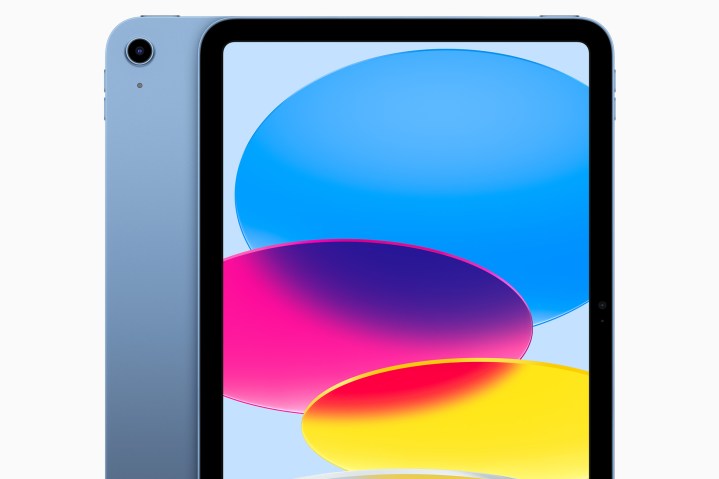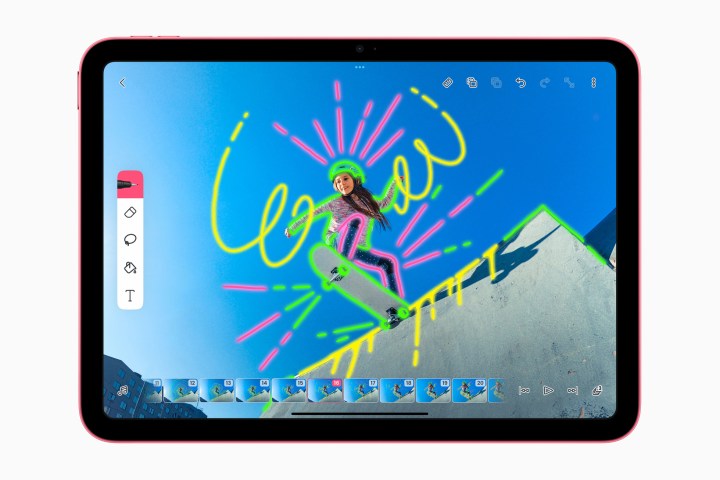The release of the iPad (2022) marks the first time we’ve seen a unified design across Apple’s complete tablet lineup in four years. The 2022 model of the entry-level iPad gains the nearly bezel-free design of its more expensive siblings and also marks the next big step in the ultimate death of Apple’s Lightning port by bringing USB-C to the entire iPad family.
While the iPad was known for nearly eight years for its iconic design that featured wide bezels and a front-and-center home button, Apple changed the game when it released a new pair of iPad Pro models in the fall of 2018. Following at least partly in the footsteps of the 2017 iPhone X, the new iPad Pro lineup adopted an edge-to-edge screen design, eliminating the home button and adopting Face ID authentication. Although the bezels shrank dramatically over prior iPad models, the larger size of Apple’s tablets allowed the company to leave enough room for the True Depth camera system needed to drive Face ID without resorting to a notched screen.

The new iPad Pro duo also introduced a new flat-edged design that would herald things to come. Two years after it debuted on the iPad Pro, Apple brought the aesthetic to the iPhone 12 lineup and a fourth-generation iPad Air, followed by the sixth-generation iPad mini in 2021. With this year’s 10-generation iPad, the circle is now complete.
Can I use Face ID on the iPad (2022)?
With a bezel-less and home button-free design, the new 2022 iPad immediately begs the question of whether Apple has brought Face ID to its most affordable tablet. Sadly, the answer to that question is a firm no.
One of the more notable design changes of the new iPad is the position of the front-facing camera, which now lives on the long edge of the tablet — a position much better suited to using the iPad in landscape orientation. The new camera placement led some folks to hope that Apple had used the extra room for a True Depth camera system.
Sadly its location is the only notable difference in camera technology from the prior model. Apple is calling it a “Landscape Ultra Wide camera,” but that seems to largely be a marketing spin, as the camera specs are identical to the one found in last year’s iPad. The iPad (2022) gains Smart HDR 3, but that’s a function of Apple’s more powerful A14 chip, not the camera itself.

The lack of Face ID shouldn’t come as much of a surprise. Apple has now released two generations of iPad Air that feature a nearly identical design to the iPad Pro, with the latest model even packing in the same M1 chip previously exclusive to the iPad Pro. However, even the latest iPad Air lacks support for Face ID.
It’s pretty clear that Apple considers Face ID an exclusive feature of the iPad Pro lineup. It’s been available on every iPad Pro released since late 2018 — that’s four new generations of Apple’s high-end tablet lineup. Yet it remains conspicuously absent on any other iPad.
By all accounts, the True Depth camera hardware that powers Face ID doesn’t come cheap, so it’s an understandable omission, particularly on Apple’s entry-level iPad. However, it’s also a way for Apple to distinguish its flagship iPad Pro from the rest of the lineup.
What biometric options are available on the iPad (2022)?
Fortunately, Apple hasn’t left fans of its budget iPad without any biometric authentication methods. Its tried-and-true Touch ID system remains. Since the home button on the front is gone, Apple has simply moved the Touch ID sensor to the top button.
This is exactly what happened with the iPad Air (2022) and the iPad mini (2021). Both those mid-range tablets featured the traditional front home button before they were treated to the new design, but since Apple wasn’t willing to bring Face ID to those models, it had to find a new home for the Touch ID sensor. The top button was the most logical place.

Touch ID works on the 2022 iPad just like it did on the last model; only the position of the sensor has changed. You’ll still be able to use your fingerprint to unlock your iPad, access secure apps, and authorize Apple Pay payments and in-app purchases.
The sensor placement may be a little more awkward for some folks, especially if you’re using a keyboard with your iPad, and it definitely requires more effort than using Face ID. However, Apple has been using a top button Touch ID sensor in its iPads for two years now, so it’s proven technology, and there’s no reason to believe it won’t work as well as it always has.
Editors' Recommendations
- Best refurbished iPad deals: Get an iPad with warranty for $109
- You’ll soon be able to control your iPhone and iPad with your eyes
- Which iPads does the Apple Pencil Pro work with? Here’s the full list
- Best Apple deals: Save on AirPods, Apple Watch, iPad, MacBook
- Apple made an outrageous change to its new iPads



